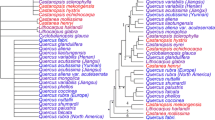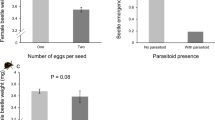Abstract
Phenolic contents were compared between Mimosa bimucronata seeds from infested and non-infested fruits to assess induced defense response. By measuring leg length of the bruchid beetle Acanthoscelides schrankiae, we verified whether phenolic contents affected bruchid body size. In addition, the relationship between physical seed traits and phenolic contents was examined. Results showed that seeds from infested fruits had significantly greater phenolic contents than seeds from non-infested fruits, which suggested induced defense. Body size variation in A. schrankiae was marginally nonsignificant according to phenolic contents among plants (negative trend), indicating that phenols may interfere directly with bruchid performance. Seeds that were more irregularly shaped had significantly greater phenolic contents than those that were more uniform. Therefore, the most perfectly spherical seeds may be more vulnerable to seed predation, and our results suggest that the production of phenolic compounds was increased in infested fruits, which in turn may affect A. schrankiae development.



Similar content being viewed by others


References
Bekker RM, Bakker JP, Grandin U, Kalamees R, Milberg P, Poschlod P, Thompson K, Willems JH (1998) Seed size, shape and vertical distribution in the soil: indicators of seed longevity. Funct Ecol 12:834–842
Boughdad A, Gillon Y, Cagnepain C (1986) Effect of condensed tannins of horse bean husks (Vicia faba) on larval development of Callosobruchus maculatus. Entomol Exp Appl 42:125–132
Burkart A (1959) Leguminosae. In: Parodi LR (ed) Enciclopedia Argentina de Agricultura y Jardineria. ACME, Buenos Aires, pp 443–512
Cope JM, Fox CW (2003) Oviposition decisions in the seed beetle, Callosobruchus maculatus (Coleoptera: Bruchidae): effects of seed size on superparasitism. J Stored Prod Res 39:355–365
Cornelissen T, Stiling P (2005) Perfect is best: low leaf fluctuating asymmetry reduces herbivory by leaf miners. Oecologia 142:46–56
Cornelissen T, Stiling P, Drake B (2003) Elevated CO2 decreases leaf fluctuating asymmetry and herbivory by leaf miners on two oak species. Global Change Biol 10:27–36
Crawley MJ (2007) The R book. Wiley, Chichester
Dana W, Ivo W (2008) Computer image analysis of seed shape and seed color for flax cultivar description. Comput Electron Agr 61:126–135
Dell'Aquila A (2007) Towards new computer imaging techniques applied to seed quality testing and sorting. Seed Sci Technol 35:519–538
Fineblum WL, Rausher MD (1995) Tradeoff between resistance and tolerance to herbivore damage in a morning glory. Nature 377:517–520
Folin O, Ciocalteau V (1927) On tyrosine and tryptophane determination in proteins. J Biol Chem 73:424–427
Fowler SV, Lawton JH (1985) Rapidly induced defenses and talking trees: the devil's advocate position. Amer Nat 126:181–195
Fox CW, Mousseau TA (1996) Larval host plant affects fitness consequences of egg size variation in the seed beetle Stator limbatus. Oecologia 107:541–548
Fox CW, Waddell KJ, Mousseau TA (1994) Host-associated fitness variation in a seed beetle (Coleoptera: Bruchidae): evidence for local adaptation to a poor quality host. Oecologia 99:329–336
Funes G, Basconcelo S, Dias S, Cabido M (1999) Seed size and shape are good predictors of seed persistence in soil in temperate mountain grasslands of Argentina. Seed Sci Res 9:341–345
Gianoli E, Suárez LH, Gonzáles WL, González-Teuber M, Acuña-Rodrígues IS (2007) Host-associated variation in sexual size dimorphism and fitness effects of adult feeding in a bruchid beetle. Entomol Exp Appl 122:233–237
Grubb PJ, Metcalfe DJ, Grubb EAA, Jones GD (1998) Nitrogen-richness and protection of seeds in Australian tropical rainforest: a test of plant defence theory. Oikos 82:467–482
Hagen SB, Folstad I, Jakobsen SW (2003) Autumn colouration and herbivore resistance in mountain birch (Betula pubescens). Ecol Lett 6:807–811
Harper JL, Lovell PH, Moore KG (1970) The shapes and sizes of seeds. Annu Rev Ecol Syst 1:327–356
Hu WT, Lan YC, Horng SB (1995) Effects of bean size on larval competition and oviposition preference of Callosobruchus maculatus. Chinese J Entomol 15:321–332
Hu ZH, Shen YB, Luo YQ, Shen FY, Gao HB, Gao RF (2008) Aldehyde volatiles emitted in succession from mechanically damaged leaves of poplar cuttings. J Plant Biol 51:269–275
Hulme PE, Benkman CW (2002) Granivory. In: Herrera CM, Pellmyr O (eds) Plant-animal interactions: an evolutionary approach. Blackwell, Oxford, pp 132–154
Illipronti Jr RA, Langerak CJ, Lommen WJM (1997) Variation in and relationships between physical and physiological seed attributes within a soybean seed lot. Seed Sci Technol 25:215–231
Illipronti Jr RA, Langerak CJ, Lommen WJM (1999) Variation in physical seed attributes relates to variation in growth of soybean seedlings within a seed lot. Seed Sci Technol 27:339–357
Janzen DH (1969) Seed-eaters versus seed size, number, toxicity and dispersal. Evolution 23:1–27
Janzen DH (1971) Seed predation by animals. Annu Rev Ecol Syst 2:465–492
Janzen DH (1980) Specificity of seed-attacking beetles in a Costa Rican deciduous forest. J Ecol 68:929–952
Johnson CD (1983) Ecosystematics of Acanthoscelides (Coleoptera: Bruchidae) of southern Mexico and Central America. Misc Publ Entomol Soc Amer 56:1–248
Johnson CD (1990) Systematics of the seed beetle genus Acanthoscelides (Bruchidae) of northern South America. Trans Am Entomol Soc 116:297–618
Jolivet P (1998) Interrelationship between insects and plants. CRC, Boca Raton
Karban R, Baldwin IT (1997) Induced responses to herbivory. University of Chicago Press, Chicago
Klug-Pumpel B, Scharfetter-Lehrl G (2008) Soil diaspore reserves above the timberline in the Austrian Alps. Flora 203:292–303
Kollmann J, Coomes DA, White SM (1998) Consistencies in post-dispersal seed predation of temperate fleshy-fruited species among seasons, years and sites. Funct Ecol 12:683–690
Lorenzi H (2000) Plantas Daninhas do Brasil: Terrestres, Aquáticas, Parasitas e Tóxicas. Instituto Plantarum, Nova Odessa
Matilla A, Gallardo M, Puga-Hermida MI (2005) Structural, physiological and molecular aspects of heterogeneity in seeds: a review. Seed Sci Res 15:63–76
Moles AT, Westoby M (2004) Seedling survival and seed size: a synthesis of the literature. J Ecol 92:372–383
Moles AT, Westoby M (2006) Seed size and plant strategy across the whole life cycle. Oikos 113:91–105
Moles AT, Hodson DW, Webb CJ (2000) Seed size and shape and persistence in the soil in the New Zealand flora. Oikos 89:541–545
Møller AP (1995) Leaf-mining insects and fluctuating asymmetry in Ulmus glabra leaves. J Anim Ecol 64:697–707
Nápoles JR (2002) Bruchidae. In: Bousquets, JL, Morrone JJ (eds), Biodiversidad, Taxonomía y Biogeografía de Artrópodos de México: Hacia Una Síntesis de su Conocimiento, vol 3. Unan, pp. 513-534
Or K, Ward D (2004) The effects of seed quality and pipecolic and djenkolic acids on bruchid beetle infestation in water deficit-stressed Acacia trees. J Chem Ecol 30:2297–2307
Parsons PA (1990) Fluctuating asymmetry: an epigenetic measure of stress. Biol Rev 65:131–145
Puerta-Piñero C, Gómez JM, Hódar JA (2008) Shade and herbivory induce fluctuating asymmetry in a Mediterranean oak. Int J Plant Sci 169:631–635
Rohner C, Ward D (1997) Chemical and mechanical defenses against herbivory in two sympatric species of desert Acacia. J Veg Sci 8:717–726
Schoonhoven LM, van Loon JJA, Dicke M (2005) Insect–plant biology. Oxford University Press, New York
Schultz JC, Baldwin IT (1982) Oak leaf quality declines in response to defoliation by gypsy moth larvae. Science 217:149–151
Silva LA, Maimoni-Rodella RCS, Rossi MN (2007) A preliminary investigation of pre-dispersal seed predation by Acanthoscelides schrankiae Horn (Coleoptera: Bruchidae) in Mimosa bimucronata (DC.) Kuntze trees. Neotrop Entomol 36:197–202
Southgate BJ (1979) Biology of the Bruchidae. Annu Rev Entomol 24:449–473
Szentesi A, Jermy T (1995) Predispersal seed predation in leguminous species: weed morphology and bruchid distribution. Oikos 73:23–32
Thanthianga C, Mitchell R (1990) The fecundity and oviposition behavior of South Indian strain Callosobruchus maculatus. Entomol Exp Appl 57:133–142
Thiery D, Jarry M, Pouzat J (1994) To penetrate or not to penetrate—a behavioral choice by bean beetle 1st instar larvae in response to Phaseolus vulgaris seed surface quality. J Chem Ecol 20:1867–1875
Thompson K, Grime JP (1979) Seasonal variation in the seed banks of herbaceous species in ten contrasting habitats. J Ecol 67:893–921
Timms R (1998) Size-independent effects of larval host on adult fitness in Callosobruchus maculatus. Ecol Entomol 23:480–483
Tomaz CA, Kestring D, Rossi MN (2007) Effects of the seed predator Acanthoscelides schrankiae on viability of its host plant Mimosa bimucronata. Biol Res 40:281–290
Tracy M, Freeman DC, Dude JL, Miglia KJ, Gram JH, Hough RA (2003) Developmental instability: an appropriate indicator of plant fitness components? In: Polak M (ed) Developmental instability: causes and consequences. Oxford University Press, New York, pp 196–212
van Huis A, de Rooy M (1998) The effect of leguminous plant species on Callosobruchus maculatus (Coleoptera: Bruchidae) and its egg parasitoid Uscana lariophaga (Hymenoptera: Trichogrammatidae). B Entomol Res 88:93–99
Yang RL, Horng SB (2002) Host size discrimination and oviposition behavior of the seed beetle, Callosobruchus maculatus (F.). Formos Entomol 22:343–357
Yang RL, Fushing H, Horng SB (2006) Effects of search experience in a resource-heterogeneous environment on the oviposition decision of the seed beetle, Callosobruchus maculatus (F.). Ecol Entomol 31:285–293
Zar JH (1999) Biostatistical analysis. Prentice Hall, Upper Saddle River
Zvereva E, Kozlov M, Haukioja E (1997) Stress responses of Salix borealis to pollution and defoliation. J Appl Ecol 34:1387–1396
Acknowledgments
We thank Professors Janet W. Reid and James Welsh for English assistance with the manuscript text. D. Kestring is grateful to CNPq (Conselho Nacional de Desenvolvimento Científico e Tecnológico). L. C. C. R. de Menezes (05/57999-3), C. A. Tomaz (04/10329-0) and M. N. Rossi (04/06737-6) thank Fapesp (Fundação de Amparo à Pesquisa do Estado de São Paulo) for financial support. We are most grateful to Jeferson Klein for technical assistance.
Author information
Authors and Affiliations
Corresponding author
Rights and permissions
About this article
Cite this article
Kestring, D., Menezes, L.C.C.R., Tomaz, C.A. et al. Relationship Among Phenolic Contents, Seed Predation, and Physical Seed Traits in Mimosa bimucronata Plants. J. Plant Biol. 52, 569–576 (2009). https://doi.org/10.1007/s12374-009-9073-3
Received:
Revised:
Accepted:
Published:
Issue Date:
DOI: https://doi.org/10.1007/s12374-009-9073-3


